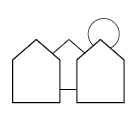Connectivity and lifestyle shifts are transforming the workplace. Companies are acknowledging the perks of telecommuting; the amount of employers offering a work from home option has increased by 40% in the last 5 years. [9]
Working from home is not only convenient, but also contributes to overall well-being and happiness. Almost all of the multi-family housing that we toured in Chicago, Madison and Denver included a designated work from home space. Although this space was included, we noticed that it was hardly used. Instead, many opted to work from the shared social spaces. Why is this? From our observations, many of the social spaces had direct access to natural light. In comparison, most of the designated working spaces were small rooms with no windows. It seems that how and where people want to work is directly impacted by the environment.
In the future, the number of telecommuters is bound to continue increasing. How will this impact the design of urban homes when the line between work and home continues to blur?
The old home office, typically crammed into a den or spare bedroom, is also likely ripe for a makeover, as people increasingly need flexible yet professional-grade space to work and create. [6]













